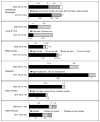Trends in snacking among U.S. children
- PMID: 20194979
- PMCID: PMC2837536
- DOI: 10.1377/hlthaff.2009.0666
Trends in snacking among U.S. children
Abstract
Nationally representative surveys of food intake in U.S. children show large increases in snacking between the 1989-91 to 1994-98 and 1994-98 to 2003-06 periods. Childhood snacking trends are moving toward three snacks per day, and more than 27 percent of children's daily calories are coming from snacks. The largest increases have been in salty snacks and candy. Desserts and sweetened beverages remain the major sources of calories from snacks.
Figures



Similar articles
-
37 year snacking trends for US children 1977-2014.Pediatr Obes. 2018 Apr;13(4):247-255. doi: 10.1111/ijpo.12220. Epub 2017 May 15. Pediatr Obes. 2018. PMID: 28508580 Free PMC article.
-
Disparities in Snacking Trends in US Adults over a 35 Year Period from 1977 to 2012.Nutrients. 2017 Jul 27;9(8):809. doi: 10.3390/nu9080809. Nutrients. 2017. PMID: 28749436 Free PMC article.
-
Significant increase in young adults' snacking between 1977-1978 and 1994-1996 represents a cause for concern!Prev Med. 2001 Apr;32(4):303-10. doi: 10.1006/pmed.2000.0817. Prev Med. 2001. PMID: 11304090
-
The patterns and position of snacking in children in aged 2-12 years: A scoping review.Appetite. 2023 Sep 1;188:106974. doi: 10.1016/j.appet.2023.106974. Epub 2023 Jul 6. Appetite. 2023. PMID: 37421978
-
A review of snacking patterns among children and adolescents: what are the implications of snacking for weight status?Child Obes. 2013 Apr;9(2):104-15. doi: 10.1089/chi.2012.0108. Epub 2013 Mar 7. Child Obes. 2013. PMID: 23470091 Review.
Cited by
-
A cross-sectional analysis of snacking habits, eating habits, physical activity, and indicators of obesity among high school students in Jakarta, Indonesia.J Public Health Res. 2021 May 31;10(s1):jphr.2021.2402. doi: 10.4081/jphr.2021.2402. J Public Health Res. 2021. PMID: 34060755 Free PMC article.
-
Frequency of Sweet and Salty Snack Food Consumption Is Associated with Higher Intakes of Overconsumed Nutrients and Weight-For-Length z Scores During Infancy and Toddlerhood.J Acad Nutr Diet. 2022 Aug;122(8):1534-1542. doi: 10.1016/j.jand.2022.02.013. Epub 2022 Feb 25. J Acad Nutr Diet. 2022. PMID: 35219920 Free PMC article.
-
Association of candy consumption with body weight measures, other health risk factors for cardiovascular disease, and diet quality in US children and adolescents: NHANES 1999-2004.Food Nutr Res. 2011;55. doi: 10.3402/fnr.v55i0.5794. Epub 2011 Jun 14. Food Nutr Res. 2011. PMID: 21691462 Free PMC article.
-
An extra virgin olive oil-enriched chocolate spread positively modulates insulin-resistance markers compared with a palm oil-enriched one in healthy young adults: A double-blind, cross-over, randomised controlled trial.Diabetes Metab Res Rev. 2022 Feb;38(2):e3492. doi: 10.1002/dmrr.3492. Epub 2021 Sep 25. Diabetes Metab Res Rev. 2022. PMID: 34435429 Free PMC article. Clinical Trial.
-
Fat Replacers in Baked Food Products.Foods. 2018 Nov 25;7(12):192. doi: 10.3390/foods7120192. Foods. 2018. PMID: 30477253 Free PMC article. Review.
References
-
- Nicklas TA, Yang SJ, Baranowski T, Zakeri I, Berenson G. Eating patterns and obesity in children. The Bogalusa Heart Study. Am J Prev Med. 2003 Jul;25(1):9–16. - PubMed
-
- Nielsen SJ, Siega-Riz AM, Popkin BM. Trends in energy intake in U.S. between 1977 and 1996: similar shifts seen across age groups. Obes Res. 2002 May;10(5):370–8. - PubMed
-
- Nicklas TA, Morales M, Linares A, Yang SJ, Baranowski T, De Moor C, et al. Children’s meal patterns have changed over a 21-year period: the Bogalusa Heart Study. J Am Diet Assoc. 2004 May;104(5):753–61. - PubMed
-
- Summerbell CD, Moody RC, Shanks J, Stock MJ, Geissler C. Relationship between feeding pattern and body mass index in 220 free-living people in four age groups. Eur J Clin Nutr. 1996 Aug;50(8):513–9. - PubMed
-
- Rocandio AM, Ansotegui L, Arroyo M. Comparison of dietary intake among overweight and non-overweight schoolchildren. Int J Obes Relat Metab Disord. 2001 Nov;25(11):1651–5. - PubMed
Publication types
MeSH terms
Grants and funding
LinkOut - more resources
Full Text Sources
Other Literature Sources
Medical

